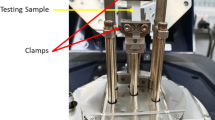Abstract
Nonlinear viscoelastic creep properties of poly (methyl methacrylate) at various temperatures and stress levels were measured in short-term tests to check the applicability of time-temperature-stress superposition principle, which is the combined form of time-temperature superposition principle and time-stress superposition principle. A unified master creep compliance curve was constructed from the short-term tests by joint application of time-temperature superposition and time-stress superposition. The unified master curve establishes the creep compliance over two years, which is 4.2 decades longer than the test duration. Moreover, it is verified that in nonlinear viscoelastic cases, the time-temperature shift factors are dependent on stresses at which the shifts are applied, while the time-stress shift factors are dependent on temperatures.
Similar content being viewed by others
References
O’Shaughnessy, W.T., An experimental study of the creep of rayon. Textile Research Journal, 1948, 18: 263–286.
Goldman, A.Y., Prediction of the Deformation Properties of Polymeric and Composite Materials. Washington DC: American Chemical Society, 1994.
Brostow, W., Time-stress correspondence in viscoelastic materials: an equation for the stress and temperature shift factor. Materials Research Innovations, 2000, 3: 347–351.
Hadid, M., Rechak, S. and Tati, A., Long-term bending creep behavior prediction of injection molded composite using stress-time correspondence principle. Materials Science and Engineering A, 2004, 385: 54–58.
Luo, W.B., Yang, T.Q. and An, Q.L., Time-temperature-stress equivalence and its application to nonlinear viscoelastic materials. Acta Mechanica Solida Sinica, 2001, 14: 195–199.
Ponsot, B., Valentin, D. and Bunsell, A.R., The effects of time, temperature and stress on the long-term behaviour of CFRP. Composites Science and Technology, 1989, 35: 75–94.
Popelar, C.H., Kenner, V.H. and Wooster, J.P., An accelerated method for establishing the long term performance of polyethylene gas pipe materials. Polymer Engineering and Science, 1991, 31: 1693–1700.
Lai, J. and Bakker, A., Analysis of the non-linear creep of high-density polyethylene. Polymer, 1995, 36: 93–99.
Luo, W.B., Wang, C.H., Vu-Khanh, T. and Jazouli, S., Time-stress equivalence: Application to nonlinear creep of polypropylene. Journal of Central South University of Technology, 2007, 14: 310–313.
Jazouli, S., Luo, W.B., Bremand, F. and Vu-Khanh, T., Application of time-stress equivalence to nonlinear creep of polycarbonate. Polymer Testing, 2005, 24: 463–467.
Jazouli, S., Luo, W.B., Bremand, F. and Vu-Khanh, T., Nonlinear creep behavior of viscoelastic polycarbonate. Journal of Materials Science, 2006, 41: 531–536.
Yen, S.C. and Williamson, F.L., Accelerated characterization of creep response of an off-axis composite material. Composites Science and Technology, 1990, 38: 103–118.
Scott, D.W., Lai, J.S. and Zureick, A.H., Creep behavior of fiber-reinforced polymeric composites: A review of the technical literature. Journal of Reinforced Plastics and Composites, 1995, 14: 588–617.
Ma, C.C.M., Tai, N.H. and Wu, S.H. et al. Creep behavior of carbon-fiber-reinforced polyetheretherketone (PEEK)[±45]4S laminated composites (I). Composites Part B: Engineering, 1997, 28: 407–417.
Knauss, W.G. and Emri, I., Volume change and nonlinearly thermo-viscoelasticity constitution of polymers. Polymer Engineering and Science, 1987, 27: 86–100.
Losi, G.U. and Knauss, W.G., Free volume theory and nonlinear thermoviscoelasticity. Polymer Engineering and Science, 1992, 32: 542–557.
Luo, W.B., Yang, T.Q. and Wang, X.Y., Effects of temperature and stress level on the free volume in high polymers. Polymeric Materials Science and Engineering, 2005, 21: 11–15 (in Chinese).
Luo, W.B., Wang, C.H. and Zhao, R.G., Application of time-temperature-stress superposition principle to nonlinear creep of Poly(methyl methacrylate). Key Engineering Materials, 2007, 340–341: 1091–1096.
Author information
Authors and Affiliations
Corresponding author
Additional information
This work was supported by NSFC(No. 11172256), NCET (No. NCET-08-0685), Key Project of Chinese Ministry of Education (No. 209085) and Aid Program for Science and Technology Innovative Research Team in Higher Educational Institutions of Hunan Province.
Rights and permissions
About this article
Cite this article
Luo, W., Wang, C., Hu, X. et al. Long-Term Creep Assessment of Viscoelastic Polymer by Time-Temperature-Stress Superposition. Acta Mech. Solida Sin. 25, 571–578 (2012). https://doi.org/10.1016/S0894-9166(12)60052-4
Received:
Revised:
Published:
Issue Date:
DOI: https://doi.org/10.1016/S0894-9166(12)60052-4




